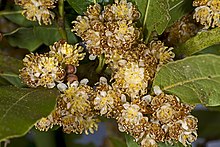
The Magnoliales are an order of flowering plants.

The Cornales are an order of flowering plants, early diverging among the asterids, containing about 600 species. Plants within the Cornales usually have four-parted flowers, drupaceous fruits, and inferior to half-inferior gynoecia topped with disc-shaped nectaries.

Hamamelidales is an order of flowering plants formerly accepted in a number of systems of plant taxonomy, including the Cronquist system published in 1968 and 1988. The order is not currently accepted in the Angiosperm Phylogeny Group III system of plant taxonomy, the most widely accepted system as molecular systematic studies have suggested that these families are not closely related to each other. The APG II system (2003) assigns them to several different orders: Hamamelidaceae and Cercidiphyllaceae to Saxifragales, Eupteleaceae to Ranunculales, Platanaceae to Proteales, and Myrothamnaceae to Gunnerales. Additional studies of the chloroplast genome have since confirmed that the families moved into the Saxigragales are closely related.

Austrobaileyales is an order of flowering plants consisting of about 100 species of woody plants growing as trees, shrubs and lianas. The best-known species is Illicium verum, commonly known as star anise. The order belongs to the group of basal angiosperms, the ANA grade, which diverged earlier from the remaining flowering plants. Austrobaileyales is sister to all remaining extant angiosperms outside the ANA grade.

Illiciales is an order of flowering plants that is not recognized by the current most widely used system of plant classification, the Angiosperm Phylogeny Group's APG III system. The order was comprised differently in various systems of plant taxonomy, but is composed of 2-4 families of shrubs, trees, and lianas native to Australasia, south eastern Asia, and the southeastern United States. The families all contain species with essential oils, and flowers with a perianth with bracts, sepals, and petals incompletely distinguished from each other and not arranged in definite whorls. The families of the order had been variably placed in other orders in different taxonomies.

Amborella is a monotypic genus of understory shrubs or small trees endemic to the main island, Grande Terre, of New Caledonia in the southwest Pacific Ocean. The genus is the only member of the family Amborellaceae and the order Amborellales and contains a single species, Amborella trichopoda. Amborella is of great interest to plant systematists because molecular phylogenetic analyses consistently place it as the sister group to all other flowering plants.
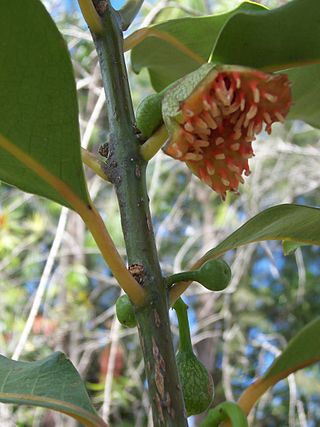
The Monimiaceae is a family of flowering plants in the magnoliid order Laurales. It is closely related to the families Hernandiaceae and Lauraceae. It consists of shrubs, small trees, and a few lianas of the tropics and subtropics, mostly in the southern hemisphere. The largest center of diversity is New Guinea, with about 75 species. Lesser centres of diversity are Madagascar, Australia, and the neotropics. Africa has one species, Xymalos monospora, as does Southern Chile. Several species are distributed through Malesia and the southwest Pacific.

Austrobaileya is the sole genus consisting of a single species that constitutes the entire flowering plant family Austrobaileyaceae. The species Austrobaileya scandens grows naturally only in the Wet Tropics rainforests of northeastern Queensland, Australia.
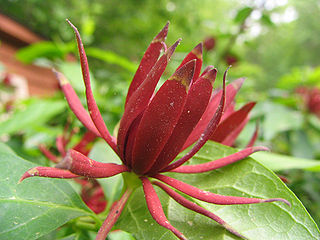
The Calycanthaceae are a small family of flowering plants in the order Laurales. The family contains three genera and only 10 known species, restricted to warm temperate and tropical regions:

In the APG IV system (2016) for the classification of flowering plants, the name asterids denotes a clade. Asterids is the largest group of flowering plants, with more than 80,000 species, about a third of the total flowering plant species. Well-known plants in this clade include the common daisy, forget-me-nots, nightshades, the common sunflower, petunias, yacon, morning glory, lettuce, sweet potato, coffee, lavender, lilac, olive, jasmine, honeysuckle, ash tree, teak, snapdragon, sesame, psyllium, garden sage, table herbs such as mint, basil, and rosemary, and rainforest trees such as Brazil nut.
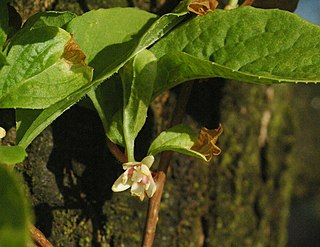
Schisandraceae is a family of flowering plants with 3 known genera and a total of 92 known species. Such a family has been recognized by most taxonomists, at least for the past several decades. Before that, the plants concerned were assigned to family Magnoliaceae and Illiciaceae.

Siparunaceae is a family of flowering plants in the magnoliid order Laurales. It consists of two genera of woody plants, with essential oils: Glossocalyx in West Africa and Siparuna in the neotropics. Glossocalyx is monospecific and Siparuna has about 74 known species.

Trimeniaceae is a family of flowering plants recognized by most taxonomists, at least for the past several decades. It is a small family of one genus, Trimenia, with eight known species of woody plants, bearing essential oils. The family is subtropical to tropical and found in Southeast Asia, eastern Australia and on several Pacific Islands.
The APG II system of plant classification is the second, now obsolete, version of a modern, mostly molecular-based, system of plant taxonomy that was published in April 2003 by the Angiosperm Phylogeny Group. It was a revision of the first APG system, published in 1998, and was superseded in 2009 by a further revision, the APG III system.

In plant taxonomy, commelinids is a clade of flowering plants within the monocots, distinguished by having cell walls containing ferulic acid.

Najadales is the botanical name of an order of flowering plants. A well-known system that used this name is the Cronquist system (1981), which used this name for an order in subclass Alismatidae with this circumscription:
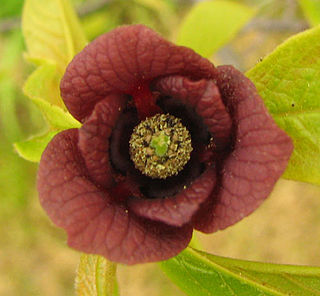
Magnoliids are a clade of flowering plants. With more than 10,000 species, including magnolias, nutmeg, bay laurel, cinnamon, avocado, black pepper, tulip tree and many others, it is the third-largest group of angiosperms after the eudicots and monocots. The group is characterized by trimerous flowers, pollen with one pore, and usually branching-veined leaves.

The basal angiosperms are the flowering plants which diverged from the lineage leading to most flowering plants. In particular, the most basal angiosperms were called the ANITA grade, which is made up of Amborella, Nymphaeales and Austrobaileyales.
The APG III system of flowering plant classification is the third version of a modern, mostly molecular-based, system of plant taxonomy being developed by the Angiosperm Phylogeny Group (APG). Published in 2009, it was superseded in 2016 by a further revision, the APG IV system.

Hydrostachys is a genus of about 22 species of flowering plants native to Madagascar and southern and central Africa. It is the only genus in the family Hydrostachyaceae. All species of Hydrostachys are aquatic, growing on rocks in fast-moving water. They have tuberous roots, usually pinnately compound leaves, and highly reduced flowers on dense spikes.
